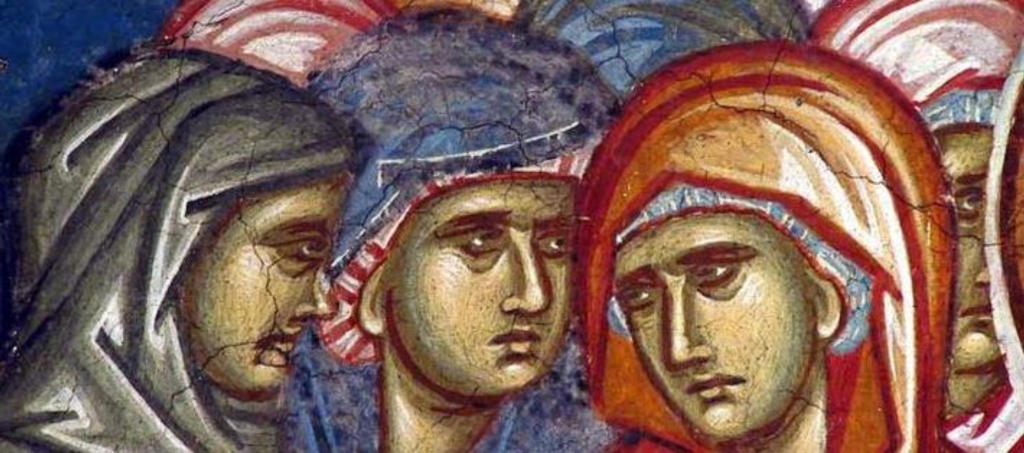
One was the wife of a high-ranking palace official, watching the inner workings of a reckless ruler. The other was the wife of a governor appointed by the most powerful man in the world. On one fateful Friday, they both crossed paths with one who held no political power but was accused of being a king. Their names were Joanna and Procula, wives of political insiders and witnesses of the trial and death of Jesus of Nazareth. Together, they represent the faithfulness of the women in both the region of Galilee and the city of Jerusalem.
Our story begins with not with Joanna and Jesus, but rather Herod Antipas and John the Baptist. Following the death of King Herod the Great, Caesar Augustus decided the Kingdom of Jews needed to be broken up with the sons of Herod given smaller pieces of the kingdom while a Roman governor controlled the lion’s share of the province of Judea with its Holy City of Jerusalem. Herod Antipas was given the small province of Galilee to rule and to make a name for himself.
And oh, how he did. He broke the heart of his first wife, an Arabian princess, by abandoning her and stealing his brother Phillip’s wife, Herodias. Such a scandal had to make life difficult for those who worked near and for Herod Antipas, including his steward Chuza and his wife Joanna. I doubt Joanna enjoyed being near Herodias or her daughter Salome. Being a righteous person, she disapproved how her husband’s boss Herod Antipas had stolen and incestuously married Herodias, his brother’s ex-wife and niece. She had to bite her tongue. John the Baptist didn’t. He called out Herod Antipas for his marital sins. Herodias had Herod Antipas to place John the Baptist in the dungeon. She wanted John the Baptist to be executed.
But Herod Antipas had respect for John the Baptist, “knowing that he was a good and holy man, he protected him. Herod was greatly disturbed whenever he talked with John, but even so, he liked to listen to him.” (Mark 6:29 NLT). Perhaps Chuza and Joanna were present when Herod Antipas spoke to John the Baptist. Unfortunately, they were probably also present at Herod Antipas’s birthday party when “ his high government officials, army officers, and the leading citizens of Galilee” were present. Salome performed a risqué dance that greatly pleased her great-uncle. When he promised her anything, Salome and her mother Herodias saw their chance. They asked for the head of John the Baptist. Chuza and Joanna were horrified when Salome came prancing and dancing with the head of John on a platter.
But John’s life was not in vain. Joanna had listened carefully as John spoke about one who was coming after him. Joanna found Jesus who healed her of her disease. Out of gratitude and love, Joanna and several other women joined Jesus for one of his tours and provided financial reports. As Luke puts it, “Soon afterward Jesus began a tour of the nearby towns and villages, preaching and announcing the Good News about the Kingdom of God. He took his twelve disciples with him, along with some women who had been cured of evil spirits and diseases. Among them were Mary Magdalene, from whom he had cast out seven demons; Joanna, the wife of Chuza, Herod’s business manager; Susanna; and many others who were contributing from their own resources to support Jesus and his disciples.” (Luke 8:1-3 NLT).
Word even reached back to Herod Antipas that Joanna and others had been healed by Jesus. But who was this Jesus? Luke picks up the story with “When Herod Antipas, the ruler of Galilee, heard about everything Jesus was doing, he was puzzled. Some were saying that John the Baptist had been raised from the dead. Others thought Jesus was Elijah or one of the other prophets risen from the dead. ‘I beheaded John,’ Herod said, ‘so who is this man about whom I hear such stories?’ And he kept trying to see him.” (Luke 9:7-9 NLT).
Things came ahead during the fateful week of Passover. Jesus rides into Jerusalem on a donkey on Palm Sunday. Throughout the week, Jesus is preaching and teaching in the Temple where all can hear him, the men and women, Jews and foreign tourists. Among the visitors with her Jewish aides providing translation was Lady Procula, wife of Roman governor Pontius Pilate. Pilate and Procula usually spent their time at the port city of Caesarea, but they would come to Jerusalem during the Jewish festivals to keep tabs on things.
On Friday, both ladies crossed paths with Jesus. For Joanna, it was when Jesus was delivered by Pilate to Herod Antipas for judgement. Joanna and Chuza watched as Herod Antipas questioned Jesus. Then they saw Antipas and his soldiers mock Jesus before sending him back to Pilate.
Back at Pilate’s Jerusalem headquarters, Procula was watching her husband creating a bigger legal mess with the trial of Jesus. Procula did not have a political position, but she had some wifely wisdom. She wrote Pilate a note, “Leave that innocent man alone. I suffered through a terrible nightmare about him last night.” (Matthew 27:19 NLT). Pilate, despite finding Jesus not guilty, gave into pollical pressure and sentenced Jesus to death.
Luke tells us that as Jesus is bearing the cross beam down the Via Delarosa to Calvary that “a large crowd trailed behind, including many grief-stricken women.” These were the local women of Jerusalem who had listened to Jesus when he would make his various pilgrimages to Jerusalem. Jesus being with Jesus though, deflected and reflected. Earlier that week on Palm Sunday, the people in Jerusalem were rejoicing as Jesus rode the donkey, just as the prophet Zechariah foretold, “Rejoice greatly, O daughter Zion! Shout aloud, O daughter Jerusalem! Lo, your king comes to you; triumphant and victorious is he, humble and riding on a donkey, on a colt, the foal of a donkey.” (Zechariah 9:9 NRSV). But the time for rejoicing was over. Now was the time of mourning. Jesus filled with sympathy turns to the women of Jerusalem and warns, “Daughters of Jerusalem, don’t weep for me, but weep for yourselves and for your children. For the days are coming when they will say, ‘Fortunate indeed are the women who are childless, the wombs that have not borne a child and the breasts that have never nursed.’ People will beg the mountains, ‘Fall on us,’ and plead with the hills, ‘Bury us.’ For if these things are done when the tree is green, what will happen when it is dry?” (Luke 23:28-31 NLT). Jesus was looking past his pain and warning Jerusalem once again about the future. If the Romans will execute the Prince of Peace, what would they do to today’s children, forty years from now, when they rashly rise and declare war against Rome?
At the crucifixion, we find that friends were standing at a distance while family members were at the foot of the cross. John’s gospel tells us that “standing near the cross were Jesus’ mother, and his mother’s sister, Mary (the wife of Clopas), and Mary Magdalene.” (John 19: 25 NLT). Matthew tells us that “And many women who had come from Galilee with Jesus to care for him were watching from a distance. Among them were Mary Magdalene, Mary (the mother of James and Joseph), and [Salome] the mother of James and John, the sons of Zebedee.” (Matthew 27:55-56 NLT). Luke, while not naming specific individuals, shows that they stayed until the bitter end: “And when all the crowd that came to see the crucifixion saw what had happened, they went home in deep sorrow. But Jesus’ friends, including the women who had followed him from Galilee, stood at a distance watching.” (Luke 23:48-49 NLT).
It was these Galilean women who followed the body of Jesus to see where it would lay. They rushed back to prepare spices for the burial, but they ran out of time. The sun had set; and the Sabbath had begun. (Luke 23:55-56). It would have been easy for them to walk away. But their love for Jesus was such that they wanted to perform one last act of generosity. They wanted to give Jesus the proper send off.
The ladies were in for a surprise. On a Sunday morning, they were informed by an angel that Jesus is risen from the dead. Luke tells us that “Then they remembered that he had said this. So they rushed back from the tomb to tell his eleven disciples—and everyone else—what had happened. It was Mary Magdalene, Joanna, Mary the mother of James, and several other women [including Salome] who told the apostles what had happened. But the story sounded like nonsense to the men, so they didn’t believe it.” (Luke 24:8-11 NLT). More significant than seeing the angel, they saw the risen Jesus.
What a joyful surprise that must have been for Joanna. She had been healed by Jesus, she supported Jesus, she traveled with Jesus, and she was with Jesus to the very end. And in her mind, she thought that Jesus had met a violent end just like John the Baptist. What Joanna didn’t realize was that in her last act of kindness, she was going to become one of the first witnesses to the Resurrection. She would be a witness that Jesus had lived, taught, healed, died, and was buried. She would also be the witness to say that the tomb was empty, and she had met the risen Lord.
It is for these acts of generosity and compassion, that Joanna and her Galilean friends, and Lady Procula and the women of Jerusalem, are heroines of the Easter story. Instead of focusing on what they couldn’t do, they focused on what they could do for Jesus.











